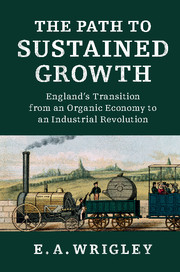 The Path to Sustained Growth
The Path to Sustained Growth Book contents
- Frontmatter
- Dedication
- Contents
- List of figures
- List of tables
- Acknowledgements
- Introduction
- 1 Organic economies
- 2 The classical economists
- 3 Energy consumption
- 4 Urban growth and agricultural productivity
- 5 Changing occupational structure and consumer demand
- 6 Demography and the economy
- 7 Transport
- 8 England in 1831
- 9 The completion of the industrial revolution
- 10 Review and reflection
- Bibliography
- Index
3 - Energy consumption
Published online by Cambridge University Press: 05 January 2016
- Frontmatter
- Dedication
- Contents
- List of figures
- List of tables
- Acknowledgements
- Introduction
- 1 Organic economies
- 2 The classical economists
- 3 Energy consumption
- 4 Urban growth and agricultural productivity
- 5 Changing occupational structure and consumer demand
- 6 Demography and the economy
- 7 Transport
- 8 England in 1831
- 9 The completion of the industrial revolution
- 10 Review and reflection
- Bibliography
- Index
Summary
Adding access to a vast stock of energy in the shape of coal to the flow of energy derived from plant photosynthesis was central to many of the changes that transformed the English economy from the mid sixteenth century onwards. The history of the changing balance between new and traditional energy sources in this period therefore deserves attention. It provides a background to many aspects of the economic and social changes that are the subject of the subsequent chapters of this book. There was a major increase in energy consumption per head of population due almost entirely to the increasing use of coal, but it is important to note that until the end of the eighteenth century coal was almost exclusively a source of heat energy. The principal traditional sources of mechanical energy, animal and human muscle, remained dominant until the early decades of the nineteenth century. It was only when the development of the steam engine made coal a convenient source of both types of energy, and it had proved possible to harness the steam engine to a very wide range of productive tasks, that the industrial revolution could be regarded as accomplished. If mechanical energy had continued to be provided almost exclusively by human and animal muscle, the constraints of an organic economy would have continued to limit growth. Because draught animals were the most important single source of mechanical energy in early modern England, increasing use of mechanical energy would only have been possible by devoting a larger and larger acreage to animal fodder, thus experiencing once again the constraint on growth that afflicted all organic economies. As Sieferle remarked, ‘The history of energy is the secret history of industrialisation’.
The growth of coal production
Table 3.1 provides coal production estimates and population totals for England over a period of three centuries. Coal production rose massively. In the mid nineteenth century, it was 270 times larger than it had been in the 1560s, and 20 times larger than in 1700. Over the three centuries in question, however, the population more than quintupled, rising from 3.04 million in 1561 to 16.73 million in 1851. Rather than considering only absolute totals of coal production, it is therefore also helpful to consider consumption per head of population in assessing change over time, and the growth rates for each of them.
- Type
- Chapter
- Information
- The Path to Sustained GrowthEngland's Transition from an Organic Economy to an Industrial Revolution, pp. 31 - 44Publisher: Cambridge University PressPrint publication year: 2016


